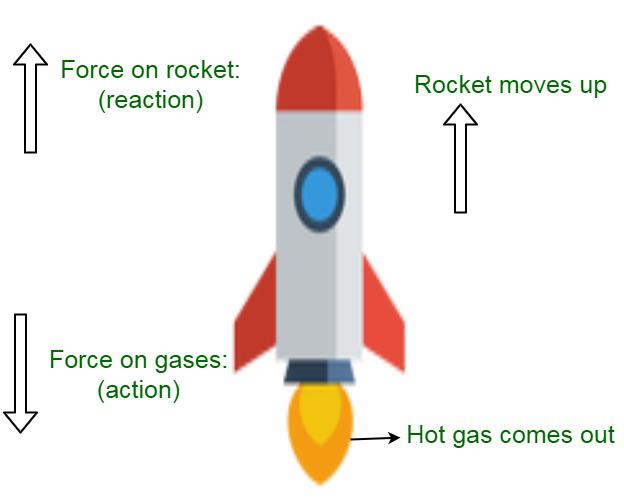UPSC Exam > UPSC Questions > In a rocket, a large volume of gases produce...
Start Learning for Free
In a rocket, a large volume of gases produced by
the combustion of fuel is allowed to escape through its tail nozzle in the downward direction with the tremendous speed and makes the rocket move upward.
Which principle is followed in this take off of the rocket?
a) Moment of inertia
b) Conservation of momentum
c) Newton’s first law of motion
d) Newton’s law of gravitation
Which principle is followed in this take off of the rocket?
a) Moment of inertia
b) Conservation of momentum
c) Newton’s first law of motion
d) Newton’s law of gravitation
Correct answer is option 'B'.
Can you explain this answer?
Can you explain this answer?
Verified Answer
In a rocket, a large volume of gases produced by ... morethe combusti...
Rocket Propulsion follow these two principles:


and can cover all the important aspects relevant from UPSC point of view through it.
View all questions of this test
1) Newton’s Third Law
2) Principle of Conservation of Momentum
Here’s the detailed explanation:
Newton's Third Law of Motion and Rocket Propulsion:
• Newton's Third Law of Motion: The principle of rocket propulsion works on the 'Newton's Third Law of Motion'. It states that, 'to every action, there is always an equal and opposite reaction'.
• Application: In the case of a rocket, the engine emits hot burning gases in the downward direction. These gases apply an equal and opposite reaction force to the rocket in the upward direction.
Principle of conservation of momentum and Rocket Propulsion:
• The principle of conservation of momentum: It states that whenever two bodies collide or get separated, then their total momentum before collision or separation is equal to their total momentum after collision or separation.
• Application: Since the gases of the rocket and the rocket are stationery at the start, their total momentum is zero. After the gases start burning, the momentum imparted to the rocket is equal and opposite to that of the gases. Hence their total momentum is zero.
Hence, Correct Answer is B
You can go through the course of Science & Technology for UPSC CSE:
Most Upvoted Answer
In a rocket, a large volume of gases produced by ... morethe combusti...
Principle Followed in Rocket Take Off
The principle followed in the take off of a rocket is the conservation of momentum.
Explanation
Conservation of momentum is a fundamental law of physics that states that the total momentum of a system of objects remains constant if no external forces act on the system. In the case of a rocket, the large volume of gases produced by the combustion of fuel is allowed to escape through its tail nozzle in the downward direction with tremendous speed. As per the conservation of momentum principle, for every action, there is an equal and opposite reaction. Hence, when the gases are expelled downwards with a high velocity, the rocket experiences an equal and opposite force, propelling it upwards.
This principle is based on Newton's Third Law of Motion, which states that for every action, there is an equal and opposite reaction. In this case, the action is the expulsion of gases downwards, and the reaction is the upward propulsion of the rocket.
Conclusion
Thus, it can be concluded that the take off of a rocket is based on the principle of conservation of momentum, which states that the total momentum of a system remains constant if no external forces act on the system. The rocket expels gases downwards with a high velocity, and the equal and opposite reaction propels it upwards.
The principle followed in the take off of a rocket is the conservation of momentum.
Explanation
Conservation of momentum is a fundamental law of physics that states that the total momentum of a system of objects remains constant if no external forces act on the system. In the case of a rocket, the large volume of gases produced by the combustion of fuel is allowed to escape through its tail nozzle in the downward direction with tremendous speed. As per the conservation of momentum principle, for every action, there is an equal and opposite reaction. Hence, when the gases are expelled downwards with a high velocity, the rocket experiences an equal and opposite force, propelling it upwards.
This principle is based on Newton's Third Law of Motion, which states that for every action, there is an equal and opposite reaction. In this case, the action is the expulsion of gases downwards, and the reaction is the upward propulsion of the rocket.
Conclusion
Thus, it can be concluded that the take off of a rocket is based on the principle of conservation of momentum, which states that the total momentum of a system remains constant if no external forces act on the system. The rocket expels gases downwards with a high velocity, and the equal and opposite reaction propels it upwards.
Free Test
FREE
| Start Free Test |
Community Answer
In a rocket, a large volume of gases produced by ... morethe combusti...
Law of conservation of momentum states that For two or more bodies in an isolated system acting upon each other, their total momentum remains constant unless an external force is applied.
Therefore, momentum can neither be created nor destroyed. Law of conservation of momentum is an important consequence of Newton’s third law of motion. Following are the examples of law of conservation of momentum:
1. Air filled balloons
2. System of gun and bullet
3. Motion of rockets

|
Explore Courses for UPSC exam
|

|
Question Description
In a rocket, a large volume of gases produced by ... morethe combustion of fuel is allowed to escape through its tail nozzle in the downward direction with the tremendous speed and makes the rocket move upward.Which principle is followed in this take off of the rocket?a) Moment of inertiab) Conservation of momentumc) Newton’s first law of motiond) Newton’s law of gravitationCorrect answer is option 'B'. Can you explain this answer? for UPSC 2025 is part of UPSC preparation. The Question and answers have been prepared according to the UPSC exam syllabus. Information about In a rocket, a large volume of gases produced by ... morethe combustion of fuel is allowed to escape through its tail nozzle in the downward direction with the tremendous speed and makes the rocket move upward.Which principle is followed in this take off of the rocket?a) Moment of inertiab) Conservation of momentumc) Newton’s first law of motiond) Newton’s law of gravitationCorrect answer is option 'B'. Can you explain this answer? covers all topics & solutions for UPSC 2025 Exam. Find important definitions, questions, meanings, examples, exercises and tests below for In a rocket, a large volume of gases produced by ... morethe combustion of fuel is allowed to escape through its tail nozzle in the downward direction with the tremendous speed and makes the rocket move upward.Which principle is followed in this take off of the rocket?a) Moment of inertiab) Conservation of momentumc) Newton’s first law of motiond) Newton’s law of gravitationCorrect answer is option 'B'. Can you explain this answer?.
In a rocket, a large volume of gases produced by ... morethe combustion of fuel is allowed to escape through its tail nozzle in the downward direction with the tremendous speed and makes the rocket move upward.Which principle is followed in this take off of the rocket?a) Moment of inertiab) Conservation of momentumc) Newton’s first law of motiond) Newton’s law of gravitationCorrect answer is option 'B'. Can you explain this answer? for UPSC 2025 is part of UPSC preparation. The Question and answers have been prepared according to the UPSC exam syllabus. Information about In a rocket, a large volume of gases produced by ... morethe combustion of fuel is allowed to escape through its tail nozzle in the downward direction with the tremendous speed and makes the rocket move upward.Which principle is followed in this take off of the rocket?a) Moment of inertiab) Conservation of momentumc) Newton’s first law of motiond) Newton’s law of gravitationCorrect answer is option 'B'. Can you explain this answer? covers all topics & solutions for UPSC 2025 Exam. Find important definitions, questions, meanings, examples, exercises and tests below for In a rocket, a large volume of gases produced by ... morethe combustion of fuel is allowed to escape through its tail nozzle in the downward direction with the tremendous speed and makes the rocket move upward.Which principle is followed in this take off of the rocket?a) Moment of inertiab) Conservation of momentumc) Newton’s first law of motiond) Newton’s law of gravitationCorrect answer is option 'B'. Can you explain this answer?.
Solutions for In a rocket, a large volume of gases produced by ... morethe combustion of fuel is allowed to escape through its tail nozzle in the downward direction with the tremendous speed and makes the rocket move upward.Which principle is followed in this take off of the rocket?a) Moment of inertiab) Conservation of momentumc) Newton’s first law of motiond) Newton’s law of gravitationCorrect answer is option 'B'. Can you explain this answer? in English & in Hindi are available as part of our courses for UPSC.
Download more important topics, notes, lectures and mock test series for UPSC Exam by signing up for free.
Here you can find the meaning of In a rocket, a large volume of gases produced by ... morethe combustion of fuel is allowed to escape through its tail nozzle in the downward direction with the tremendous speed and makes the rocket move upward.Which principle is followed in this take off of the rocket?a) Moment of inertiab) Conservation of momentumc) Newton’s first law of motiond) Newton’s law of gravitationCorrect answer is option 'B'. Can you explain this answer? defined & explained in the simplest way possible. Besides giving the explanation of
In a rocket, a large volume of gases produced by ... morethe combustion of fuel is allowed to escape through its tail nozzle in the downward direction with the tremendous speed and makes the rocket move upward.Which principle is followed in this take off of the rocket?a) Moment of inertiab) Conservation of momentumc) Newton’s first law of motiond) Newton’s law of gravitationCorrect answer is option 'B'. Can you explain this answer?, a detailed solution for In a rocket, a large volume of gases produced by ... morethe combustion of fuel is allowed to escape through its tail nozzle in the downward direction with the tremendous speed and makes the rocket move upward.Which principle is followed in this take off of the rocket?a) Moment of inertiab) Conservation of momentumc) Newton’s first law of motiond) Newton’s law of gravitationCorrect answer is option 'B'. Can you explain this answer? has been provided alongside types of In a rocket, a large volume of gases produced by ... morethe combustion of fuel is allowed to escape through its tail nozzle in the downward direction with the tremendous speed and makes the rocket move upward.Which principle is followed in this take off of the rocket?a) Moment of inertiab) Conservation of momentumc) Newton’s first law of motiond) Newton’s law of gravitationCorrect answer is option 'B'. Can you explain this answer? theory, EduRev gives you an
ample number of questions to practice In a rocket, a large volume of gases produced by ... morethe combustion of fuel is allowed to escape through its tail nozzle in the downward direction with the tremendous speed and makes the rocket move upward.Which principle is followed in this take off of the rocket?a) Moment of inertiab) Conservation of momentumc) Newton’s first law of motiond) Newton’s law of gravitationCorrect answer is option 'B'. Can you explain this answer? tests, examples and also practice UPSC tests.

|
Explore Courses for UPSC exam
|

|
Signup for Free!
Signup to see your scores go up within 7 days! Learn & Practice with 1000+ FREE Notes, Videos & Tests.



















